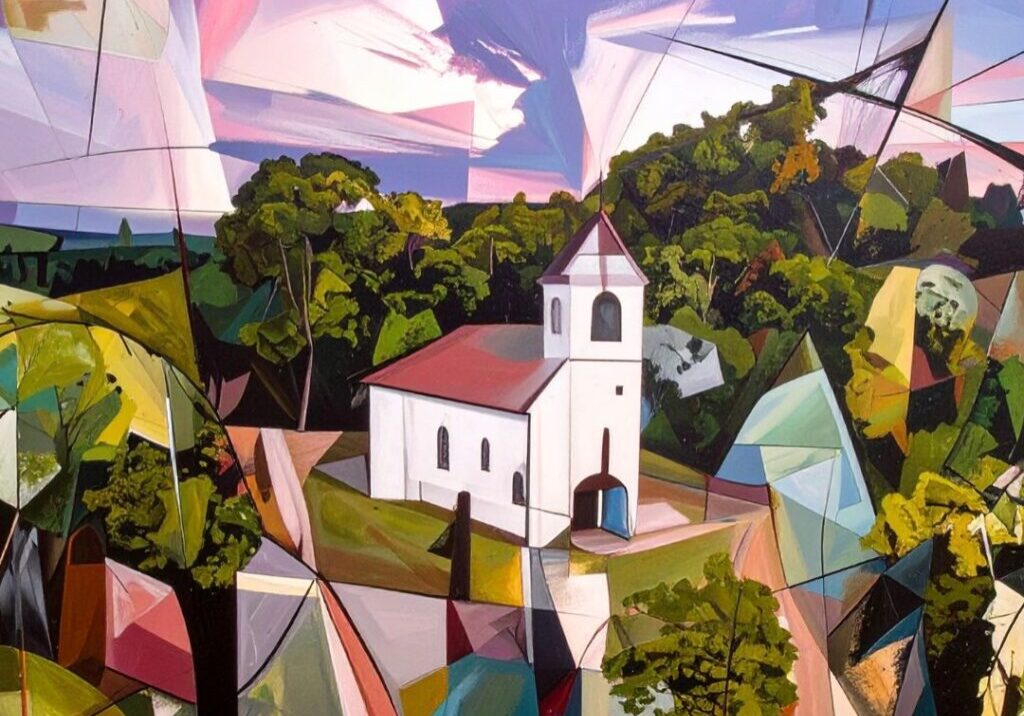Coming Home to the Sacred Heart of Jesus
 In her recent blog, “The Risen Christ and the Power of Love” (April 10, 2022) Ilia Delio wrote with great appreciation for her high school experiences of Ukrainian culture, as well as the deep faith of the Ukrainian people, despite their displacement under Stalin, and the life-giving practice of centering one’s heart in the heart of God. One cannot help but feel the heaviness of pain for the Ukrainian people who are, yet again, displaced, due to the Russian invasion of Ukraine. As of May 10, 2022, the UN estimated that more than 12 million people have fled their homes in Ukraine since the beginning of the conflict, with almost 6 million having left for neighboring countries and another 6.5 million people believed to be displaced within the country.[1] And, according to the UN High Commissioner for Refugees (UNHCR), an average of 21.5 million people are annually displaced by weather related events. By 2050 there could be 1.2 billion climate refugees.[2]
In her recent blog, “The Risen Christ and the Power of Love” (April 10, 2022) Ilia Delio wrote with great appreciation for her high school experiences of Ukrainian culture, as well as the deep faith of the Ukrainian people, despite their displacement under Stalin, and the life-giving practice of centering one’s heart in the heart of God. One cannot help but feel the heaviness of pain for the Ukrainian people who are, yet again, displaced, due to the Russian invasion of Ukraine. As of May 10, 2022, the UN estimated that more than 12 million people have fled their homes in Ukraine since the beginning of the conflict, with almost 6 million having left for neighboring countries and another 6.5 million people believed to be displaced within the country.[1] And, according to the UN High Commissioner for Refugees (UNHCR), an average of 21.5 million people are annually displaced by weather related events. By 2050 there could be 1.2 billion climate refugees.[2]
Theologian Douglas Burton-Christie explains that the need to be rooted is fundamental to the human soul. To have a sense of place, he maintains, is to “feel oneself at home in the world.”[3] It is to belong. The findings of cognitive science support the claim that sense of place is central to human meaning-making. Drawing upon the work of Leonard Talmy, cognitive scientist Steven Pinker identifies location in space and force (agency or causation) as the two fundamental metaphors in language which generate all other metaphors.[4] Ecologist and philosopher David Abram further illuminates this idea when he describes the land as “the sensible site or matrix wherein meaning occurs and proliferates.”[5] Gustavo Teran and Gustavo Esteva argue that a sense of place, a prominent theme in the literature of ecology and environmentalism, is essential in establishing a bond between the human and natural worlds and in cultivating responsible behaviors toward the places we inhabit.[6]
Sociologist Frank Fromherz contends that stories connect the storyteller and listener to places, experiences, and memories. He suggests that by contemplating a particular geography, one might recover a capacity to recollect the communities that have shaped human character. Particular places, he asserts, can unlock memories and lessons that may help restore a sense of roots. Fromherz explains that one may discover that their own story shares the same soil as those of others as they explore how communities of memory and a sense of place emerge in narrative. Drawing upon Robert Bellah’s Habits of the Heart, he speaks of “communities of memory”–memories of achievements and shared sufferings that provide a sense of group identity and connection. Fromherz advocates that we, as humans, turn to our stories, not just as personal or autobiographical narratives, but as “wellsprings of social and ecological memory vital to the development of ethical imagination and vision.”[7] He encourages us to enter into the communities of memory that have shaped our character and, in doing so, come to recognize these communities as ecological, geological, and cosmological.
But what becomes of these land-based communities of memory when people are displaced? As a person displaced by hurricane Katrina over a decade and a half ago, I have a deep empathy and compassion for those displaced by climate change and war. Although my landing 1,471 miles away in another state was perhaps softer than most of the world’s refugees, I understand well the need to find a way back home within oneself when one’s physical sense of place has been lost. In the months after Katrina, psychologist Jim O’Neill, my friend and colleague, and I provided a day of recollection entitled “Finding Your Way Back Home: the Place that Storms Can’t Destroy” for groups of displaced Katrina survivors in Mississippi and Louisiana. Over the years that followed I continued to cultivate a spirituality of grounded groundlessness which allowed me to come home, wherever I was.
At the recent Center for Christogenesis retreat, “Contemplation in Teilhard’s Universe,” Episcopal priest, mystic and writer Cynthia Bourgeault guided the participants through an embodied meditation on the Jesus Prayer, “Lord Jesus Christ have mercy on me,” in which she led us into the Sacred Heart of Jesus. She explained that the words “mercy” and “womb” share a common root. During my recovery from hurricane Katrina, I discovered a spirit-filled enclave in the woods of North Adams, Massachusetts, where I relocated, which I affectionately called “the womb place” – a place in which I found peace, sanctuary, healing, and a sense of wholeness. Cynthia’s guided meditation helped me to connect my experience years ago to the Sacred Heart of Jesus. She explained that seeing is a function of the heart and that we can see our way forward.
Ilia Delio later spoke of “entangled contemplation,” which “unifies God and the world into a new Christic reality.” In this unity we become more whole. Ilia shared the words of a prayer by Beatrice Bruteau: “…You are all of us, as we are united in You. You are all of us as we live in one another. You are all of us in the whole cosmos as we join in Your exuberant act of creation.”[8] United in contemplation, Ilia explained, we ‘suffer with’ others, opening up new dimensions of love.
Contemplation on the Sacred Heart of Jesus brings to mind the river in Herman Hesse’s story of Siddhartha. After years of eventful physical and spiritual wanderings that do not lead to the happiness that he seeks, Siddhartha comes to live with Vasudeva, the ferryman, and finds himself and, ultimately, the divine, in the river, which invites him into a transformative relationship.
And once again, when the river swelled in the rainy season and was roaring mightily, Siddhartha said: “Is it not true, O friend, that the river has many voices, very many voices. Does it not have the voice of a king, and of a warrior, and of a bull, and of a night bird, and of a woman giving birth, and of a sighing man, and a thousand other voices?”
“It is so,” nodded Vasudeva, “the voices of all creatures are in its voice.”[9]
…He could no longer distinguish the many voices . . .everything was one, everything was entwined and entwisted, was interwoven a thousandfold. . . .[10]
The voices of refugees were surely there as well. At a time when any response to the tragic displacement, loss and suffering caused by war and climate change seems inadequate, the Sacred Heart of Christ is the only space that is large enough to fully hold one another and creation in self-emptying love. It provides a way for us to come home together, giving new form to the landscape and language of the soul, and restoring a sense of belonging to the larger life community. Within the Sacred Heart may we see our way forward to new, life-giving soils of action in the world on behalf of those who cannot physically come home.
Lord Jesus Christ have mercy on us.
Notes:
[1] The 6.5 million figure is based on research conducted by the International Organization for Migration (IOM) between March 9-16. The total is believed to have increased since then. (BBC News, 5-11-2022, https://www.bbc.com/news/world-60555472).
[2] https://www.zurich.com/en/media/magazine/2022/there-could-be-1-2-billion-climate-refugees-by-2050-here-s-what-you-need-to-know. In March 2018, the UN Human Rights Council called them “the world’s forgotten victims” because many who have been forced to leave their homes as a result of climate change do not fit the legal definition of “refugees.” Thus, they do not have access to legal protections to their human rights.
[3] Burton-Christie, D. “A Sense of Place.” The Way 39:1, 1999, p.64, p. 59.
[4] Pinker, S., How the mind works. New York, W.W. Norton and Company, 1997.
[5] Abram, D., The Spell of the Sensuous: Perception and Language in a More-Than-Human World. 1st ed. New York: Vintage Books, 1996, p.140.
[6] Teran, G. and Esteva, G., Education, ecology and culture: Stories from the margins, In Progressive Perspectives, Year 2000 Monograph Series, Vol. 3, No. 1, Fall 2000, The John Dewey Project on Progressive Education, College of Education and Social Services, University of Vermont, 2000.
[7] Fromherz, F. “A sense of place.” In C. J. Dempsey & R. A. Butkus (Eds.), All creation is groaning: An interdisciplinary vision for life in a sacred universe (pp. 313). Collegeville, MN: The Liturgical Press, 1999, p. 242.
[8] Beatrice Bruteau, The Grand Option, Notre Dame: University of Notre Dame Press, 2001, p. 172-73
[9] Hesse, H. Siddhartha. New York: Penguin Books, 1922, 1999, p. 95.
[10] Hesse, H. Siddhartha. New York: Penguin Books, 1922, 1999, p. 119.
 View print-friendly version
View print-friendly version
Related Posts

Mission for an Evolutionary Christianity
We are living through tumultuous times. Political polarization intensifies, violence against vulnerable populations escalates, and the foundational principles of human dignity face erosion. For many, the cognitive dissonance between professed…

